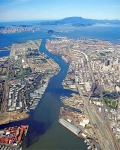| |
|
| |
| Port Name | |
Port of Oakland |

Port of Oakland | | State | |
California | | Total Trade | |
5,541,066 | | Foreign Imports | |
5,747,563 | | Foreign Exports | |
6,976,939 | | Foreign Total | |
12,724,502 | | Domestic Total | |
2,816,564 | | | | Description | |
he Port of Oakland was the first major port on the Pacific Coast of the United States to build terminals for container ships. It is now the fourth busiest container port in the United States; behind Long Beach, Los Angeles, and Newark. Development of an intermodal container handling system in 2002 culminated over a decade of planning and construction to produce a high volume cargo facility that positions the Port of Oakland for further expansion of West Coast freight market share.
| | | | Key Factor | |
One of the main limitations to growth was the inability to transfer containers to rail lines, all cranes historically operating between ocean vessels and trucks. In the 1980s the Port of Oakland began the evaluation of development of an intermodal container transfer capability, i.e. facilities that would allow trans-loading of containers from vessels to either trucks or rail modes. The Port retained VZM, Korve Engineering and Earth Metrics to perform engineering and environmental studies to allow detailed engineering to proceed. In 1987, on behalf of the Oakland port Commission, Allen Broussard led a group of 72 lawyers and city officials on a 3-week long trip to China meeting the Mayor of Shanghai, Jiang Zemin (Shanghai is twinned with San Francisco).
Completion of the resulting rail intermodal facility occurred in 2002. That brought the cumulative investment of port expansion to over 1.4 billion dollars since 1962, half of which was comprised by the intermodal facility. In the early 2000s, the new intermodal rail facility along with severe congestion at the Ports of Los Angeles and Long Beach caused some trans-Pacific shippers to move some of their traffic to the Port of Oakland (especially if the final destination is not in Southern California but lies farther east). Also, the Port is now reaping the benefits of investment in post-panamax cranes, dredging, and the transfer of military property, which has now been used for expansion.
|
|
